
|
Now it is bright as 10.1 mag (Oct. 13, Marco Goiato). It will brighten up to 9 mag, and will be observable in good condition in winter.
Date(TT) R.A. (2000) Decl. Delta r Elong. m1 Best Time(A, h)
Oct. 23 6 38.90 25 31.4 0.433 1.217 110 9.6 4:33 ( 0, 80)
Oct. 30 7 9.02 26 9.9 0.424 1.211 110 9.3 4:36 ( 0, 81)
|

|
It brightened very rapidly. Now it is very bright as 9.5 mag (Oct. 13, Marco Goiato). It stays bright as 8-9 mag until October. The condition is bad in this apparition. In the Southern Hemisphere, it stays observable after this while the comet will be fading. But it stays locating low. It is not observable after this in the Northern Hemisphere.
Date(TT) R.A. (2000) Decl. Delta r Elong. m1 Best Time(A, h)
Oct. 23 11 55.74 -35 39.7 2.003 1.325 35 9.6 4:48 (307,-10)
Oct. 30 12 21.86 -39 7.4 2.067 1.390 35 10.0 4:53 (311,-11)
|
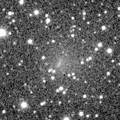
|
Now it is bright as 11.6 mag (Oct. 4, Carlos Labordena). It is observable at 10 mag in good condition from October to December. In the Northern Hemisphere, it locates somewhat low at the high light.
Date(TT) R.A. (2000) Decl. Delta r Elong. m1 Best Time(A, h)
Oct. 23 20 8.99 -31 35.2 1.038 1.414 88 9.9 18:40 ( 8, 23)
Oct. 30 20 36.47 -31 47.3 1.095 1.439 86 9.9 18:33 ( 7, 23)
|
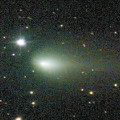
|
Now it is bright as 10.9 mag (Oct. 17, Osamu Miyazaki). It stays observable at 10-11 mag in excellent condition from summer to autumn.
Date(TT) R.A. (2000) Decl. Delta r Elong. m1 Best Time(A, h)
Oct. 23 6 38.80 12 59.3 1.061 1.680 109 10.4 4:33 ( 0, 68)
Oct. 30 6 46.73 11 53.3 1.031 1.701 114 10.4 4:14 ( 0, 67)
|

|
Now it is 10.5 mag (Oct. 14, Osamu Miyazaki). It stays bright as 10 mag until spring for a long time. In the Northern Hemisphere, it stays observable in good condition for a long time. In the Southern Hemisphere, it locates extremely low until November.
Date(TT) R.A. (2000) Decl. Delta r Elong. m1 Best Time(A, h)
Oct. 23 7 44.00 41 17.0 3.343 3.626 98 10.5 4:48 (234, 78)
Oct. 30 7 46.18 40 40.7 3.234 3.614 104 10.4 4:53 (214, 83)
|
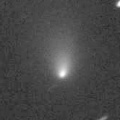
|
Now it is 12.3 mag (Oct. 10, Michael Jager). It will approach to Earth down to 0.2 a.u. in December, and it is expected to brighten up to 4 mag. In the Northern Hemisphere, it stays observable in good condition for a long time until December while the comet is brightening gradually. In the Southern Hemisphere, it is not observable until mid December.
Date(TT) R.A. (2000) Decl. Delta r Elong. m1 Best Time(A, h)
Oct. 23 11 40.30 35 36.8 1.844 1.529 55 11.7 4:48 (247, 33)
Oct. 30 11 48.59 35 2.3 1.628 1.422 60 11.1 4:53 (250, 37)
|
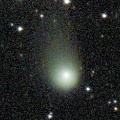
|
Now it is bright as 11.6 mag (Oct. 3, Osamu Miyazaki). It is expected to be observable at 5-6 mag for a long time from 2022 to 2023. In the Northern Hemisphere, it is not observable at the high light from 2022 autumn to 2023 summer. In the Southern Hemisphere, it stays low for a while. But it will be observable in good condition at the high light.
Date(TT) R.A. (2000) Decl. Delta r Elong. m1 Best Time(A, h)
Oct. 23 17 8.31 22 14.2 5.451 5.013 59 11.7 18:40 ( 90, 41)
Oct. 30 17 12.00 21 1.1 5.450 4.952 55 11.6 18:33 ( 91, 37)
|
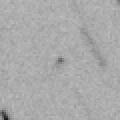
|
Now it is 13.4 mag (Oct. 8, Chris Wyatt). It will brighten rapidly up to 9 mag in winter. It will be observable in good condition. In the Southern Hemisphere, it is observable in excellent condition. In the Northren Hemisphere, it is not observable until November.
Date(TT) R.A. (2000) Decl. Delta r Elong. m1 Best Time(A, h)
Oct. 23 23 5.98 -54 54.9 1.202 1.752 105 12.0 20:58 ( 0, 0)
Oct. 30 23 4.12 -52 43.0 1.195 1.703 101 11.7 20:29 ( 0, 3)
|
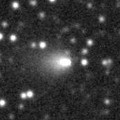
|
Major outburst occured on Oct. 17. Now it is very bright as 11.9 mag (Oct. 17, Francois Kugel). It stays observable in the evening sky for a while.
Date(TT) R.A. (2000) Decl. Delta r Elong. m1 Best Time(A, h)
Oct. 23 18 22.32 -21 1.7 1.872 1.721 65 11.8 18:40 ( 37, 24)
Oct. 30 18 41.90 -20 55.0 1.924 1.724 63 11.9 18:33 ( 37, 24)
|

|
It brightened up to 9.5 mag in early summer (June 27, Marco Goiato). Now it is fading. But it is bright as 11.4 mag still now (Oct. 4, Carlos Labordena). It will be unobservable soon in the Northern Hemisphere, or in November in the Southern Hemisphere.
Date(TT) R.A. (2000) Decl. Delta r Elong. m1 Best Time(A, h)
Oct. 23 17 4.58 -28 21.7 2.932 2.392 48 11.8 18:40 ( 47, 8)
Oct. 30 17 20.15 -29 25.9 3.031 2.434 45 12.0 18:33 ( 47, 6)
|
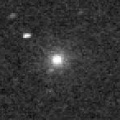
|
It was observed at 9-10 mag from late July to early August. Now it is not observable. It will appear in the morning sky in December, but it will be fainter than 15 mag at that time.
Date(TT) R.A. (2000) Decl. Delta r Elong. m1 Best Time(A, h)
Oct. 23 13 46.30 -5 25.3 2.471 1.485 5 12.7 4:48 (267,-14)
Oct. 30 14 2.60 -7 52.0 2.563 1.581 6 13.0 4:53 (271,-12)
|
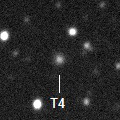
|
Now it is 13.8 mag (Oct. 9, Chris Wyatt). It is expected to brighten up to 11.5 mag in 2022. In the Southern Hemisphere, it stas observable in good condition for a long time, although it became extremely low temporarily from August to September. It is getting observable also in the Northern Hemisphere.
Date(TT) R.A. (2000) Decl. Delta r Elong. m1 Best Time(A, h)
Oct. 23 11 5.82 -25 26.2 5.349 4.646 41 13.1 4:48 (306, 5)
Oct. 30 11 12.87 -25 54.3 5.276 4.623 44 13.1 4:53 (311, 9)
|
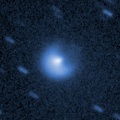
|
Major outburst occured on Sept. 25. Now it is very bright as 11.3 mag (Oct. 17, Osamu Miyazaki).
Date(TT) R.A. (2000) Decl. Delta r Elong. m1 Best Time(A, h)
Oct. 23 4 54.89 32 12.9 5.204 5.924 132 13.4 2:50 ( 0, 87)
Oct. 30 4 52.71 32 15.6 5.132 5.926 139 13.3 2:21 ( 0, 87)
|

|
It brightened up to 12.3 mag from spring to summer (June 15, Marco Goiato). Now it is fading. It has already faded down to 13.8 mag (Sept. 8, Chris Wyatt). Now it is not observable. It will be observable again at 14 mag in November in the Northern Hemisphere, or in January in the Southern Hemisphere.
Date(TT) R.A. (2000) Decl. Delta r Elong. m1 Best Time(A, h)
Oct. 23 14 4.53 -1 59.4 4.756 3.780 10 13.9 18:40 ( 94,-10)
Oct. 30 14 7.80 -1 38.3 4.775 3.810 12 13.9 4:53 (265,-10)
|
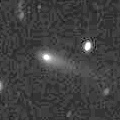
|
Now it is 13.1 mag (Oct. 8, Toshihiko Ikemura, Hirohisa Sato). It is observable at 14 mag in excellent condition in autumn.
Date(TT) R.A. (2000) Decl. Delta r Elong. m1 Best Time(A, h)
Oct. 23 0 21.99 -3 7.8 0.754 1.705 153 14.0 22:14 ( 0, 52)
Oct. 30 0 23.71 -3 32.9 0.776 1.698 147 14.0 21:48 ( 0, 52)
|

|
Now it is not observable. In the Southern Hemisphere, it will appear in the morning sky at 11 mag in late January, then it stays observable at 11 mag until June. In the Northern Hemisphere, it will appear in the morning sky in December, but it stays locating extremely low for a long time.
Date(TT) R.A. (2000) Decl. Delta r Elong. m1 Best Time(A, h)
Oct. 23 13 53.81 -8 14.2 3.090 2.098 3 14.5 18:40 ( 91,-16)
Oct. 30 14 8.80 -9 36.6 3.046 2.057 4 14.3 4:53 (272,-14)
|

|
It brightened very rapidly up to 10.7 mag in July (July 20, Osamu Miyazaki). Now it is fading. It has already faded down to 15.9 mag (Oct. 8, Toshihiko Ikemura, Hirohisa Sato). It stays observable in the morning sky for a long time.
Date(TT) R.A. (2000) Decl. Delta r Elong. m1 Best Time(A, h)
Oct. 23 8 44.68 25 50.8 1.487 1.684 82 14.6 4:48 (283, 64)
Oct. 30 8 52.56 25 49.3 1.474 1.750 88 15.1 4:53 (291, 69)
|

|
It will brighten up to 12 mag from winter to spring. Now it is not observable. In the Northern Hemisphere, it will appear in the morning sky at 14 mag in November. In the Southern Hemisphere, it is not observable until January.
Date(TT) R.A. (2000) Decl. Delta r Elong. m1 Best Time(A, h)
Oct. 23 12 42.65 2 48.8 2.874 1.986 21 14.8 4:48 (269, 4)
Oct. 30 12 58.10 1 4.4 2.809 1.948 24 14.6 4:53 (273, 6)
|

|
Now it is 14.7 mag (Oct. 9, Chris Wyatt). It stays 14-15 mag until the end of 2021. In the Southern Hemisphere, it stays observable in good condition for a long time. It locates low in the Northern Hemisphere.
Date(TT) R.A. (2000) Decl. Delta r Elong. m1 Best Time(A, h)
Oct. 23 22 26.27 -26 34.0 4.120 4.667 117 15.1 20:18 ( 0, 29)
Oct. 30 22 24.53 -25 28.1 4.236 4.688 111 15.1 19:49 ( 0, 30)
|
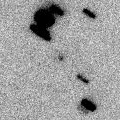
|
Now it is 17.1 mag (Oct. 8, Thomas Lehmann). It will brightens rapidly. And it is expected to be observable at 12-13 mag in good condition from December to February. However, it is much fainter than this ephemeris recently.
Date(TT) R.A. (2000) Decl. Delta r Elong. m1 Best Time(A, h)
Oct. 23 21 41.52 -8 47.2 0.768 1.493 115 15.4 19:34 ( 0, 46)
Oct. 30 21 44.53 -9 29.7 0.767 1.436 108 15.1 19:10 ( 0, 46)
|

|
Now it is 14.3 mag (Oct. 1, Toshihiko Ikemura, Hirohisa Sato). It will be fading after this. In the Northern Hemisphere, it stays observable in good condition for a long time, although it becomes extremely low temporarily in November. In the Southern Hemisphere, it is not observable until late January.
Date(TT) R.A. (2000) Decl. Delta r Elong. m1 Best Time(A, h)
Oct. 23 16 6.41 18 8.0 2.913 2.315 44 15.1 18:40 ( 94, 26)
Oct. 30 16 6.43 17 36.8 2.977 2.326 41 15.2 18:33 ( 97, 22)
|
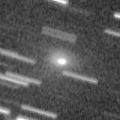
|
Now it is 14.3 mag (Oct. 4, Michael Jager). It stays 15 mag until November. It will be observable in excellent condition in the Northern Hemisphere. It locates somewhat low in the Southern Hemisphere.
Date(TT) R.A. (2000) Decl. Delta r Elong. m1 Best Time(A, h)
Oct. 23 6 55.51 28 20.0 1.132 1.714 107 15.1 4:48 (355, 83)
Oct. 30 7 5.73 29 27.3 1.096 1.732 111 15.2 4:33 ( 0, 84)
|

|
Now it is 14.9 mag (Oct. 6, Chris Wyatt). It stays 13-14 mag from 2020 to 2021. It will be observable in good condition after this in the Southern Hemisphere. It locates low in the Northern Hemisphere.
Date(TT) R.A. (2000) Decl. Delta r Elong. m1 Best Time(A, h)
Oct. 23 19 24.92 -33 55.6 3.178 3.137 78 15.2 18:40 ( 18, 19)
Oct. 30 19 33.58 -33 32.8 3.284 3.152 73 15.3 18:33 ( 20, 18)
|

|
Now it is 16.0 mag (Aug. 16, iTelescope Observatory, Siding Spring). It is expected to brighten up to 13 mag in 2022. In the Southern Hemisphere, it stays observable in good condition for a long time, although it becomes extremely low temporarily from September to October. In the Northern Hemisphere, it is not observable for a while.
Date(TT) R.A. (2000) Decl. Delta r Elong. m1 Best Time(A, h)
Oct. 23 12 32.00 -33 8.6 4.712 3.864 28 15.2 4:48 (301,-15)
Oct. 30 12 35.34 -34 37.4 4.643 3.826 31 15.2 4:53 (305,-10)
|
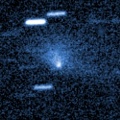
|
It brightened up to 10.1 mag in spring (Apr. 10, Marco Goiato). Now it is fading. It has already faded down to 15.3 mag (Oct. 14, Sandor Szabo). It stays observable in good condition for a long time after this while the comet will fading.
Date(TT) R.A. (2000) Decl. Delta r Elong. m1 Best Time(A, h)
Oct. 23 4 48.67 6 7.2 1.624 2.435 135 15.2 2:44 ( 0, 61)
Oct. 30 4 43.37 5 47.4 1.612 2.478 143 15.3 2:11 ( 0, 61)
|

|
Now it is 15.9 mag (Oct. 8, Thomas Lehmann). It stays at 14-15 mag for a long time from 2021 to 2022. It will be unobservable from November to January.
Date(TT) R.A. (2000) Decl. Delta r Elong. m1 Best Time(A, h)
Oct. 23 16 27.82 -20 58.5 5.727 4.994 39 15.3 18:40 ( 58, 7)
Oct. 30 16 30.52 -21 48.3 5.799 4.993 32 15.3 18:33 ( 60, 3)
|

|
Now it is 14.9 mag (Oct. 9, Chris Wyatt). It was expected to brighten up to 13 mag from spring to summer. But actually, it is fainter than originally expected. It will be fading slowly after this. In the Southern Hemisphere, it stays observable in good condition for a long time. In the Northern Hemisphere, it is not observable until July in 2022.
Date(TT) R.A. (2000) Decl. Delta r Elong. m1 Best Time(A, h)
Oct. 23 21 28.15 -74 31.4 3.708 3.762 85 15.3 19:22 ( 0,-19)
Oct. 30 21 38.64 -72 37.4 3.773 3.781 82 15.4 19:05 ( 0,-17)
|
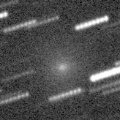
|
Bright new periodic comet. Now it is 14.5 mag (Oct. 8, Toshihiko Ikemura, Hirohisa Sato). It stays observable in good condition for a long time. It stays 14-15 mag until November. Juan Jose Gonzalez reported it is very bright as 11.8 mag on Oct. 7.
Date(TT) R.A. (2000) Decl. Delta r Elong. m1 Best Time(A, h)
Oct. 23 9 42.09 6 13.7 1.499 1.390 64 15.3 4:48 (297, 42)
Oct. 30 9 57.96 3 57.7 1.497 1.429 66 15.4 4:53 (303, 43)
|

|
Now it is 15.8 mag (Oct. 4, Thomas Lehmann). Now it is not observable. It will appear in the morning sky at 15 mag in January. Then it will brighten up to 13 mag in 2022 summer.
Date(TT) R.A. (2000) Decl. Delta r Elong. m1 Best Time(A, h)
Oct. 23 14 55.36 -15 44.4 4.228 3.287 16 15.4 18:40 ( 76, -7)
Oct. 30 15 5.33 -16 35.8 4.239 3.275 12 15.4 18:33 ( 76,-10)
|

|
Now it is 16.2 mag (Oct. 1, Thomas Lehmann). It will brighten up to 12.5 mag in 2022 summer. In the Southern Hemisphere, it stays observable in excellent condition for a long time. In the Northern Hemisphere, it is not observable until August in 2022.
Date(TT) R.A. (2000) Decl. Delta r Elong. m1 Best Time(A, h)
Oct. 23 1 34.20 -76 14.6 4.167 4.325 92 15.5 23:22 ( 0,-21)
Oct. 30 0 54.32 -76 28.4 4.179 4.279 89 15.4 22:15 ( 0,-21)
|
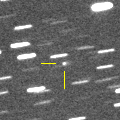
|
It brightened rapidly. Now it is 15.5 mag (Oct. 14, Sandor Szabo). It will be observable at 15 mag in excellent condition in winter.
Date(TT) R.A. (2000) Decl. Delta r Elong. m1 Best Time(A, h)
Oct. 23 8 13.08 22 26.0 2.263 2.456 89 15.6 4:48 (300, 68)
Oct. 30 8 20.68 21 39.1 2.177 2.457 94 15.6 4:53 (315, 72)
|

|
Now it is 15.7 mag (Oct. 2, Toshihiko Ikemura, Hirohisa Sato). It is expected to brighten up to 11 mag in 2023. In the Northern Hemisphere, it stays observable in good condition for a long time. It is not observable in the Southern Hemisphere.
Date(TT) R.A. (2000) Decl. Delta r Elong. m1 Best Time(A, h)
Oct. 23 16 9.67 34 38.0 6.262 5.775 56 15.7 18:40 (111, 34)
Oct. 30 16 11.71 33 50.8 6.246 5.732 54 15.7 18:33 (112, 30)
|
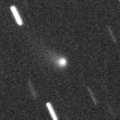
|
Now it is 15.9 mag (Sept. 24, D. Buczynski). In the Northern Hemisphere, it stays observable at 15-16 mag for a long time until early 2022, although it becomes extremely low temporarily from September to October. In the Southern Hemisphere, it is not observable until the end of 2021.
Date(TT) R.A. (2000) Decl. Delta r Elong. m1 Best Time(A, h)
Oct. 23 13 4.74 24 36.7 3.799 3.071 37 15.7 4:48 (248, 12)
Oct. 30 13 8.09 23 10.0 3.773 3.086 40 15.7 4:53 (253, 17)
|

|
It brightened up to 9.7 mag in June (June 4, Michael Jager). Now it is fading. It has already faded down to 14.1 mag (Sept. 11, Chris Wyatt). In the Southern Hemisphere, it stays observable in excellent condition for a long time. In the Northern Hemisphere, it becomes extremely low after this.
Date(TT) R.A. (2000) Decl. Delta r Elong. m1 Best Time(A, h)
Oct. 23 23 16.79 -41 21.5 1.430 2.076 116 15.7 21:09 ( 0, 14)
Oct. 30 23 19.29 -39 16.1 1.538 2.130 112 16.1 20:44 ( 0, 16)
|

|
Now it is 14.8 mag (Oct. 3, Michael Jager). It stays 15 mag until October, and it is observable in good condition.
Date(TT) R.A. (2000) Decl. Delta r Elong. m1 Best Time(A, h)
Oct. 23 23 3.58 -17 16.7 1.544 2.313 129 15.7 20:56 ( 0, 38)
Oct. 30 23 5.83 -17 10.1 1.616 2.319 123 15.8 20:31 ( 0, 38)
|
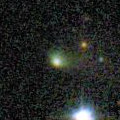
|
Now it is 15.5 mag (Oct. 14, Sandor Szabo). It continues brightening even after the perihelion passage. It may stay 15-16 mag for a while.
Date(TT) R.A. (2000) Decl. Delta r Elong. m1 Best Time(A, h)
Oct. 23 0 58.62 -14 43.1 2.077 2.987 151 15.8 22:50 ( 0, 40)
Oct. 30 0 56.36 -14 51.2 2.154 3.023 145 15.9 22:20 ( 0, 40)
|
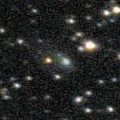
|
Now it is 15.4 mag (Oct. 1, Toshihiko Ikemura, Hirohisa Sato). It is expected to brighten up to 11 mag from spring to summer in 2022. In the Southen Hemisphere, it locates somewhat low in 2021, but it will be observable in good condition at the high light for a long time. In the Northern Hemisphere, it is observable in good condition in 2021, but it will not be observable at the high light.
Date(TT) R.A. (2000) Decl. Delta r Elong. m1 Best Time(A, h)
Oct. 23 18 35.87 8 57.5 3.436 3.302 73 15.9 18:40 ( 57, 50)
Oct. 30 18 37.25 6 52.2 3.480 3.239 67 15.8 18:33 ( 60, 45)
|
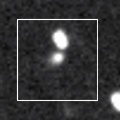
|
Now it is 16.6 mag (July 29, Thomas Lehmann). It is expected to brighten up to 10 mag in 2023. In the Northern Hemisphere, it stays observable in good condition until 2023 autumn, although it became extremely low temporarily in September. In the Southern Hemipshere, it stays unobservable until 2023 summer.
Date(TT) R.A. (2000) Decl. Delta r Elong. m1 Best Time(A, h)
Oct. 23 12 39.87 34 0.2 6.668 6.051 48 15.9 4:48 (243, 21)
Oct. 30 12 43.56 34 13.8 6.544 5.996 52 15.9 4:53 (245, 27)
|

|
Now it is 16.0 mag (Oct. 8, Toshihiko Ikemura, Hirohisa Sato). It stays observable in good condition for a long time. But it will be fading after this.
Date(TT) R.A. (2000) Decl. Delta r Elong. m1 Best Time(A, h)
Oct. 23 22 54.79 2 3.1 1.386 2.210 135 16.0 20:47 ( 0, 57)
Oct. 30 22 55.88 2 25.8 1.455 2.220 129 16.0 20:21 ( 0, 58)
|
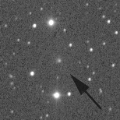
|
It brightened up to 14.2 mag in early summer (June 10, Thomas Lehmann). Now it is fading. In the Northern Hemisphere, it is appearing in the morning sky. In the Southern Hemisphere, it will never be observable again.
Date(TT) R.A. (2000) Decl. Delta r Elong. m1 Best Time(A, h)
Oct. 23 12 53.76 27 8.9 2.967 2.307 40 16.0 4:48 (247, 15)
Oct. 30 13 9.87 28 14.4 2.947 2.351 44 16.1 4:53 (248, 19)
|

|
Now it is 17.5 mag (Oct. 10, Toshihiko Ikemura, Hirohisa Sato). It will brighten up to 15.5 mag in winter. In the Northern Hemisphere, it stays observable in good condition for a long time. It is not observable at all in the Southern Hemisphere.
Date(TT) R.A. (2000) Decl. Delta r Elong. m1 Best Time(A, h)
Oct. 23 15 40.49 62 51.3 3.190 3.124 77 16.2 18:40 (146, 37)
Oct. 30 15 43.23 62 25.2 3.152 3.101 77 16.1 18:33 (146, 34)
|
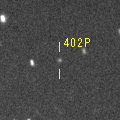
|
First return of a new periodic comet observed at 16 mag from 2003 to 2004. Now it is 17.0 mag (Sept. 27, ATLAS-MLO, Mauna Loa). It will brighten up to 16 mag in winter, and it will be observable in excellent condition.
Date(TT) R.A. (2000) Decl. Delta r Elong. m1 Best Time(A, h)
Oct. 23 6 40.17 0 54.7 3.539 3.949 107 16.2 4:35 ( 0, 56)
Oct. 30 6 41.13 0 47.4 3.446 3.947 113 16.1 4:08 ( 0, 56)
|
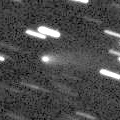
|
Now it is 16.0 mag (Oct. 1, Toshihiko Ikemura, Hirohisa Sato). It will be fading after this, and it will be fainter than 18 mag in December. In the Northern Hemisphere, it stays observable in good condition for a long time. It locates extremely low in the Southern Hemisphere.
Date(TT) R.A. (2000) Decl. Delta r Elong. m1 Best Time(A, h)
Oct. 23 8 15.40 33 45.8 1.332 1.677 91 16.2 4:48 (269, 73)
Oct. 30 8 30.45 34 59.1 1.305 1.708 95 16.3 4:53 (266, 77)
|
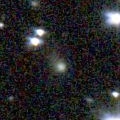
|
Now it is 16.2 mag (Oct. 1, Toshihiko Ikemura, Hirohisa Sato). It is expected to brighten up to 11 mag in 2023. In the Northern Hemisphere, it is observable in good condition in 2021. But it is observable only until November in 2022. In the Southern Hemisphere, it locates extremely low in 2021. But it will be observable in good condition at the high light.
Date(TT) R.A. (2000) Decl. Delta r Elong. m1 Best Time(A, h)
Oct. 23 17 34.16 27 0.7 6.282 5.956 66 16.3 18:40 ( 93, 48)
Oct. 30 17 37.27 25 51.3 6.295 5.907 62 16.3 18:33 ( 93, 44)
|

|
Now it is 15.8 mag (Oct. 2, Toshihiko Ikemura, Hirohisa Sato). It will be unobservable in November.
Date(TT) R.A. (2000) Decl. Delta r Elong. m1 Best Time(A, h)
Oct. 23 16 56.91 -7 55.8 5.517 4.881 46 16.3 18:40 ( 63, 21)
Oct. 30 17 1.89 -7 30.5 5.592 4.887 41 16.3 18:33 ( 66, 18)
|

|
Now it is 16.2 mag (Oct. 7, Thomas Lehmann). It is observable at 16 mag from 2020 to 2021. It locates low in the Southern Hemisphere.
Date(TT) R.A. (2000) Decl. Delta r Elong. m1 Best Time(A, h)
Oct. 23 21 34.94 30 18.7 5.636 6.170 118 16.5 19:27 ( 0, 85)
Oct. 30 21 32.89 28 45.2 5.726 6.183 113 16.6 18:57 ( 0, 84)
|
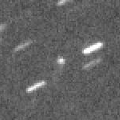
|
Now it is 17.0 mag (Oct. 2, Toshihiko Ikemura, Hirohisa Sato). It will brighten up to 16 mag in 2022. In the Northern Hemisphere, it stays observable in good condition for a long time. In the Southern Hemisphere, it is not observable until 2023.
Date(TT) R.A. (2000) Decl. Delta r Elong. m1 Best Time(A, h)
Oct. 23 9 16.87 61 16.6 3.981 4.101 89 16.6 4:48 (210, 55)
Oct. 30 9 25.86 63 26.6 3.873 4.077 94 16.5 4:53 (204, 56)
|

|
Outburst occured in early August, and it brightened up to 14.1 mag (Aug. 7, Michael Jager). Now it is fading. It has already faded down to 17.5 mag (Oct. 8, Toshihiko Ikemura, Hirohisa Sato). In the Northern Hemisphere, it stays observable in good condition. In the Southern Hemipsphere, it stays locating extremely low after this.
Date(TT) R.A. (2000) Decl. Delta r Elong. m1 Best Time(A, h)
Oct. 23 6 0.15 47 22.0 2.146 2.742 116 16.6 3:56 (180, 78)
Oct. 30 5 59.20 47 59.0 2.103 2.771 122 16.7 3:27 (180, 77)
|

|
It was expected to brighten up to 14.5 mag from spring to summer. But actually, it is fainter than expected. Now it is 16.4 mag (Oct. 4, ATLAS-MLO, Mauna Loa). In the Southern Hemisphere, it stays observable for a long time. In the Northern Hemisphere, it is not observable after this.
Date(TT) R.A. (2000) Decl. Delta r Elong. m1 Best Time(A, h)
Oct. 23 11 42.35 -51 33.4 3.843 3.260 47 16.6 4:48 (322,-17)
Oct. 30 11 47.83 -51 40.3 3.878 3.301 48 16.6 4:53 (325,-14)
|
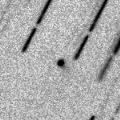
|
Michael Jager detected its cometary activity on Sept. 25. Now it is bright as 16.2 mag (Oct. 3, Michael Jager). It approaches to Earth down to 0.35 a.u. in early October, and it is observable at 16 mag in excellent condition.
Date(TT) R.A. (2000) Decl. Delta r Elong. m1 Best Time(A, h)
Oct. 23 0 36.26 -6 36.7 0.397 1.364 154 16.6 22:29 ( 0, 48)
Oct. 30 0 49.55 -10 17.8 0.432 1.378 147 17.0 22:15 ( 0, 45)
|

|
It brightened up to 11.6 mag in winter (Feb. 18, Thomas Lehmann). Now it is fading. It has already faded down to 15.8 mag (Sept. 15, Thomas Lehmann). In the Southern Hemisphere, it stays observable in good condition after this. In the Northern Hemisphere, it will never be observable after this.
Date(TT) R.A. (2000) Decl. Delta r Elong. m1 Best Time(A, h)
Oct. 23 3 9.68 -70 26.4 3.919 4.161 97 16.6 1:05 ( 0,-15)
Oct. 30 2 44.72 -70 1.5 4.002 4.225 96 16.7 0:13 ( 0,-15)
|
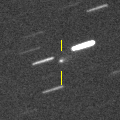
|
Now it is 16.6 mag (Oct. 8, Toshihiko Ikemura, Hirohisa Sato). It stays observable at 17 mag from autumn to winter. In the Northern Hemisphere, it stays observable in good condition. In the Southern Hemisphere, it stays extremely low until November.
Date(TT) R.A. (2000) Decl. Delta r Elong. m1 Best Time(A, h)
Oct. 23 10 28.67 14 17.5 2.139 1.785 56 16.7 4:48 (279, 38)
Oct. 30 10 44.32 12 22.4 2.095 1.793 58 16.7 4:53 (284, 40)
|

|
Now it is 16.6 mag (Oct. 3, Toshihiko Ikemura, Hirohisa Sato). It stays at 16-17 mag from 2020 to 2021. In the Northern Hemisphere, it stays observable in good condition for a long time. In the Southern Hemisphere, it is not observable after this.
Date(TT) R.A. (2000) Decl. Delta r Elong. m1 Best Time(A, h)
Oct. 23 18 20.66 47 58.9 8.966 8.919 84 16.8 18:40 (127, 60)
Oct. 30 18 22.00 47 40.6 9.008 8.925 82 16.8 18:33 (125, 57)
|
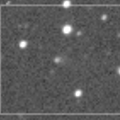
|
First return of a new periodic comet which brightened up to 17 mag in 2006. Now it is 17.4 mag (Sept. 27, N. Paul, E. Cortes). It stays 17 mag from 2021 to 2022.
Date(TT) R.A. (2000) Decl. Delta r Elong. m1 Best Time(A, h)
Oct. 23 21 35.61 -58 6.6 2.934 3.158 93 16.8 19:29 ( 0, -3)
Oct. 30 21 40.34 -56 9.8 2.992 3.150 89 16.9 19:06 ( 0, -1)
|
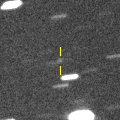
|
Now it is 17.3 mag (Oct. 2, Toshihiko Ikemura, Hirohisa Sato). It will brighten up to 15.5 mag, and will be observable in excellent condition in winter.
Date(TT) R.A. (2000) Decl. Delta r Elong. m1 Best Time(A, h)
Oct. 23 9 42.43 13 26.9 2.196 2.011 66 16.9 4:48 (289, 46)
Oct. 30 9 56.71 12 32.3 2.128 2.009 69 16.8 4:53 (294, 49)
|

|
Now it is 17.1 mag (Oct. 2, Toshihiko Ikemura, Hirohisa Sato). It will brighten rapidly, and it will be observable at 13.5 mag in good condition from winter to spring.
Date(TT) R.A. (2000) Decl. Delta r Elong. m1 Best Time(A, h)
Oct. 23 9 14.86 19 36.1 2.913 2.813 74 17.1 4:48 (287, 55)
Oct. 30 9 23.46 19 3.7 2.797 2.788 79 16.9 4:53 (294, 60)
|
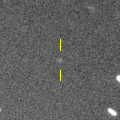
|
Now it is 16.4 mag (Sept. 27, ATLAS-MLO, Mauna Loa). It continues brightening even after the perihelion passage. It stays observable at 17 mag in good condition for a while.
Date(TT) R.A. (2000) Decl. Delta r Elong. m1 Best Time(A, h)
Oct. 23 5 9.73 -15 7.5 3.084 3.731 123 16.9 3:05 ( 0, 40)
Oct. 30 5 7.31 -15 39.0 3.048 3.749 128 16.9 2:35 ( 0, 39)
|

|
Now it is 17.7 mag (May 12, ATLAS-HKO, Haleakala). It brightened rapidly. It stays 17 mag for a long time from 2021 to 2022. In the Southern Hemisphere, it stays observable in good condition for a long time. In the Northern Hemisphere, it will be observable only in extremely low sky from autumn to winter.
Date(TT) R.A. (2000) Decl. Delta r Elong. m1 Best Time(A, h)
Oct. 23 9 9.14 -28 19.8 5.639 5.335 67 16.9 4:48 (329, 19)
Oct. 30 9 9.03 -29 57.3 5.556 5.333 72 16.9 4:53 (336, 21)
|
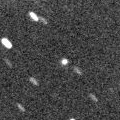
|
Now it is 17.5 mag (Oct. 1, Toshihiko Ikemura, Hirohisa Sato). It is expected to brighten up to 4.5 mag in 2022 April. However, it is not observable at the high light. In the Northern Hemisphere, it stays observable until early February when it brightens up to 14 mag. Then it will appear at 6 mag in mid May, and it stays observable in good condition after that while the comet will be fading. In the Southern Hemisphere, it stays observable until December when it brightens up to 16 mag. But after that, it is not observable until 2022 August.
Date(TT) R.A. (2000) Decl. Delta r Elong. m1 Best Time(A, h)
Oct. 23 22 4.84 17 8.6 2.567 3.246 125 17.2 19:57 ( 0, 72)
Oct. 30 22 0.53 15 19.1 2.562 3.155 118 17.0 19:25 ( 0, 70)
|
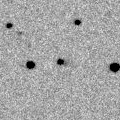
|
Now it is 15.6 mag (Oct. 13, Sandor Szabo). It is observable at 16-17 mag in good condition in autumn. It is brighter than this ephemeris recently.
Date(TT) R.A. (2000) Decl. Delta r Elong. m1 Best Time(A, h)
Oct. 23 2 20.26 15 56.8 2.813 3.799 171 17.0 0:16 ( 0, 71)
Oct. 30 2 16.85 15 18.3 2.805 3.798 178 17.0 23:41 ( 0, 70)
|

|
Now it is 16.7 mag (Oct. 2, Toshihiko Ikemura, Hirohisa Sato). In the Northern Hemisphere, it stays observable in good condition after this while the comet will be fading. In the Southern Hemisphere, it stays locating extremely low for a long time.
Date(TT) R.A. (2000) Decl. Delta r Elong. m1 Best Time(A, h)
Oct. 23 5 23.86 41 44.9 2.241 2.921 124 17.2 3:19 (180, 83)
Oct. 30 5 19.77 42 16.0 2.226 2.977 131 17.1 2:48 (180, 83)
|

|
Now it is 18.4 mag (Oct. 2, Toshihiko Ikemura, Hirohisa Sato). It stays 17-18 mag for a long time from 2021 to 2022. It is observable in excellent condition in the Northern Hemisphere, It locates somewhat low in the Southern Hemisphere.
Date(TT) R.A. (2000) Decl. Delta r Elong. m1 Best Time(A, h)
Oct. 23 5 0.62 34 20.6 4.792 5.495 130 17.2 2:56 ( 0, 89)
Oct. 30 4 51.24 34 28.7 4.691 5.484 139 17.1 2:20 ( 0, 90)
|
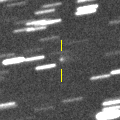
|
Now it is 17.2 mag (Sept. 20, Ken-ichi Kadota). In the Northern Hemisphere, it stays observable at 17 mag in good condition until winter. In the Southern Hemisphere, it stays locating extremely low for a while.
Date(TT) R.A. (2000) Decl. Delta r Elong. m1 Best Time(A, h)
Oct. 23 8 48.15 28 59.5 1.973 2.099 83 17.3 4:48 (276, 65)
Oct. 30 8 57.27 27 51.3 1.921 2.126 87 17.3 4:53 (284, 69)
|

|
Now it is 17.1 mag (Oct. 3, Toshihiko Ikemura, Hirohisa Sato). Fading slowly. In the Northern Hemisphere, it stays observable in good condition for a long time. It is not observable after this in the Southern Hemisphere.
Date(TT) R.A. (2000) Decl. Delta r Elong. m1 Best Time(A, h)
Oct. 23 16 20.00 48 12.4 6.234 5.936 68 17.4 18:40 (127, 40)
Oct. 30 16 22.80 47 54.5 6.276 5.971 67 17.4 18:33 (127, 37)
|
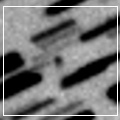
|
Now it is 17.6 mag (Oct. 10, Toshihiko Ikemura, Hirohisa Sato). It is expected to brighten up to 11 mag in 2022 summer. In the Northern Hemisphere, it stays observable in good condition until 2022 June when it brightens up to 11 mag. But it is not observable after the high light. In the Souther Hemisphere, it is not observable until 2022 October.
Date(TT) R.A. (2000) Decl. Delta r Elong. m1 Best Time(A, h)
Oct. 23 23 18.81 62 46.1 3.291 3.910 121 17.5 21:10 (180, 62)
Oct. 30 23 5.89 62 5.3 3.229 3.837 121 17.4 20:29 (180, 63)
|

|
First return of a new periodic comet which brightened up to 17 mag in 2011. Now it is 17.2 mag (Sept. 16, Catalina Sky Survey). It stays observable at 17 mag in good condition until 2022 spring.
Date(TT) R.A. (2000) Decl. Delta r Elong. m1 Best Time(A, h)
Oct. 23 10 32.56 12 52.2 1.960 1.603 54 17.5 4:48 (280, 36)
Oct. 30 10 52.32 11 4.2 1.905 1.588 56 17.4 4:53 (284, 38)
|

|
Now it is 18.4 mag (Oct. 10, Toshihiko Ikemura, Hirohisa Sato). It will brighten up to 16.5-17 mag in winter. In its last apparition in 2015, it brightened up to 13 mag.
Date(TT) R.A. (2000) Decl. Delta r Elong. m1 Best Time(A, h)
Oct. 23 21 46.92 -32 15.4 1.586 2.110 107 17.4 19:40 ( 0, 23)
Oct. 30 21 50.81 -31 35.7 1.623 2.070 101 17.4 19:16 ( 0, 24)
|
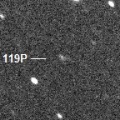
|
Now it is 17.1 mag (Oct. 2, Toshihiko Ikemura, Hirohisa Sato). It will brighten up to 15 mag in 2022 winter. In 2021, it stays observable in good condition while the comet will be brightening gradually.
Date(TT) R.A. (2000) Decl. Delta r Elong. m1 Best Time(A, h)
Oct. 23 22 22.58 -19 3.4 2.385 3.016 120 17.5 20:15 ( 0, 36)
Oct. 30 22 22.93 -18 49.7 2.446 2.990 113 17.5 19:48 ( 0, 36)
|
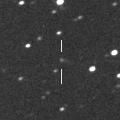
|
Now it is 17.4 mag (Sept. 29, ATLAS-HKO, Haleakala). It will brighten up to 14 mag in early 2023. It stays observable in good condition for a long time until spring.
Date(TT) R.A. (2000) Decl. Delta r Elong. m1 Best Time(A, h)
Oct. 23 4 53.49 3 2.7 4.667 5.403 133 17.7 2:49 ( 0, 58)
Oct. 30 4 51.89 2 50.4 4.558 5.358 140 17.6 2:20 ( 0, 58)
|

|
Now it is 18.7 mag (Oct. 14, Catalina Sky Survey). In the Northern Hemisphere, it stays observable at 17 mag in good condition from November to December. It locates low in the Southern Hemisphere.
Date(TT) R.A. (2000) Decl. Delta r Elong. m1 Best Time(A, h)
Oct. 23 4 27.38 40 15.2 1.515 2.326 134 18.0 2:23 (180, 85)
Oct. 30 4 13.13 40 19.6 1.433 2.306 143 17.7 1:42 (180, 85)
|

|
First return of a new periodic comet which brightened up to 17 mag in 2012. Now it is 18.0 mag (Sept. 26, ATLAS-MLO, Mauna Loa). It is observable in excellent condition in the Southern Hemisphere. It locates low in the Northern Hemisphere.
Date(TT) R.A. (2000) Decl. Delta r Elong. m1 Best Time(A, h)
Oct. 23 21 10.07 -29 38.5 0.762 1.367 101 17.8 19:04 ( 0, 26)
Oct. 30 21 30.69 -26 48.2 0.781 1.363 99 17.9 18:57 ( 0, 28)
|

|
Now it is 21.4 mag (Aug. 19, Pan-STARRS 1, Haleakala). In the Northern Hemisphere, it stays observable at 17 mag in good condition from November to March. It locates low in the Southern Hemisphere.
Date(TT) R.A. (2000) Decl. Delta r Elong. m1 Best Time(A, h)
Oct. 23 6 4.05 20 7.2 2.109 2.728 118 18.0 3:59 ( 0, 75)
Oct. 30 6 6.07 20 37.2 2.012 2.707 125 17.8 3:34 ( 0, 76)
|
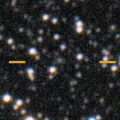
|
Now it is 17.4 mag (Oct. 2, Toshihiko Ikemura, Hirohisa Sato). It stays observable at 17-18 mag for a long time from 2021 to 2022.
Date(TT) R.A. (2000) Decl. Delta r Elong. m1 Best Time(A, h)
Oct. 23 19 24.22 -18 48.2 4.127 4.081 80 17.8 18:40 ( 23, 33)
Oct. 30 19 29.71 -18 40.6 4.225 4.078 74 17.9 18:33 ( 27, 32)
|
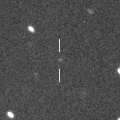
|
Now it is 18.1 mag (Oct. 2, Toshihiko Ikemura, Hirohisa Sato). It has passed the perihelion in 2020 October. At the discovery in 2005, it stayed bright for several years even after the perihelion passage. In this apparition, it may stay observable at 18 mag from 2021 to 2024.
Date(TT) R.A. (2000) Decl. Delta r Elong. m1 Best Time(A, h)
Oct. 23 23 16.19 -28 59.0 3.414 4.070 125 17.9 21:08 ( 0, 26)
Oct. 30 23 15.30 -28 33.5 3.516 4.093 119 18.0 20:40 ( 0, 27)
|

|
It brightened up to 3 mag in December in the SOHO spacecraft images in 2020 December (Dec. 18, Hirohisa Sato). Now it is 17.6 mag (Oct. 1, Toshihiko Ikemura, Hirohisa Sato). It stays observable in good condition after this while the comet will be fading.
Date(TT) R.A. (2000) Decl. Delta r Elong. m1 Best Time(A, h)
Oct. 23 23 10.31 12 38.1 3.891 4.706 141 17.9 21:02 ( 0, 68)
Oct. 30 23 7.79 11 53.0 4.037 4.781 133 18.1 20:32 ( 0, 67)
|

|
Now it is 18.1 mag (Oct. 3, Michael Jager). Main-belt asteroid, but it has a long tail of 10 arcmin. It stays observable in good condition until winter.
Date(TT) R.A. (2000) Decl. Delta r Elong. m1 Best Time(A, h)
Oct. 23 23 35.34 -2 41.3 1.645 2.518 143 19.9 21:27 ( 0, 52)
Oct. 30 23 34.10 -2 49.5 1.715 2.529 136 20.0 20:59 ( 0, 52)
|
|
![]()
 254P/McNaught
254P/McNaught C/2020 F7 ( Lemmon )
C/2020 F7 ( Lemmon ) C/2021 O3 ( PanSTARRS )
C/2021 O3 ( PanSTARRS ) P/2021 N2 ( Fuls )
P/2021 N2 ( Fuls ) 28P/Neujmin 1
28P/Neujmin 1 C/2020 U4 ( PanSTARRS )
C/2020 U4 ( PanSTARRS ) 241P/LINEAR
241P/LINEAR C/2019 K7 ( Smith )
C/2019 K7 ( Smith ) C/2021 P4 ( ATLAS )
C/2021 P4 ( ATLAS ) 430P/2021 Q2 ( Scotti )
430P/2021 Q2 ( Scotti ) 230P/LINEAR
230P/LINEAR 119P/Parker-Hartley
119P/Parker-Hartley C/2020 S4 ( PanSTARRS )
C/2020 S4 ( PanSTARRS ) (3200) Phaethon
(3200) Phaethon 424P/2021 L5 ( La Sagra )
424P/2021 L5 ( La Sagra ) 274P/Tombaugh-Tenagra
274P/Tombaugh-Tenagra 395P/2020 H1 ( Catalina-NEAT )
395P/2020 H1 ( Catalina-NEAT ) 378P/2019 E2 ( McNaught )
378P/2019 E2 ( McNaught ) C/2020 S3 ( Erasmus )
C/2020 S3 ( Erasmus ) 433P/(248370) 2005 QN173
433P/(248370) 2005 QN173![]()






































































